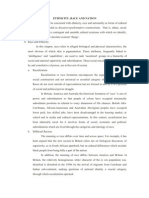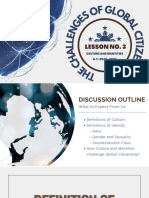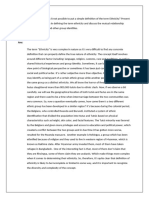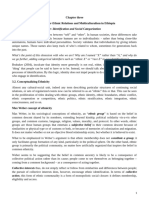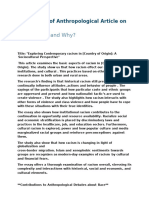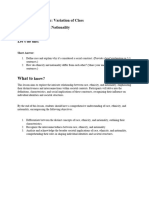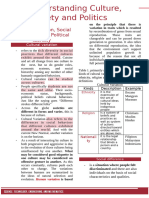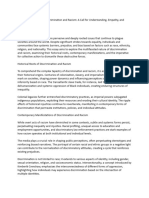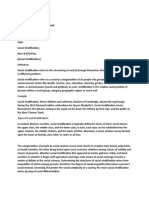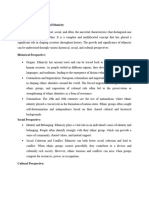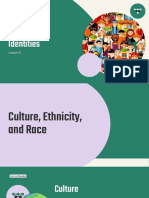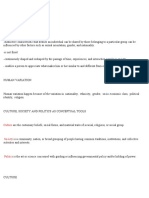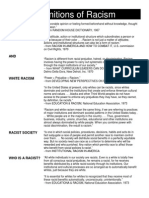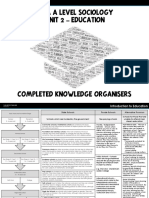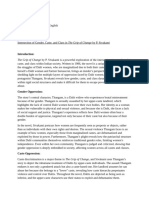0 ratings0% found this document useful (0 votes)
7 viewsRace
Race
Uploaded by
Zeeshan NasirThis document discusses the concepts of race and ethnicity including how they are social constructs that have been used to justify discrimination and inequality. It also addresses how race, ethnicity and other social identities intersect and how understanding their social construction can help challenge oppression and foster more inclusive societies.
Copyright:
© All Rights Reserved
Available Formats
Download as DOCX, PDF, TXT or read online from Scribd
Race
Race
Uploaded by
Zeeshan Nasir0 ratings0% found this document useful (0 votes)
7 views3 pagesThis document discusses the concepts of race and ethnicity including how they are social constructs that have been used to justify discrimination and inequality. It also addresses how race, ethnicity and other social identities intersect and how understanding their social construction can help challenge oppression and foster more inclusive societies.
Copyright
© © All Rights Reserved
Available Formats
DOCX, PDF, TXT or read online from Scribd
Share this document
Did you find this document useful?
Is this content inappropriate?
This document discusses the concepts of race and ethnicity including how they are social constructs that have been used to justify discrimination and inequality. It also addresses how race, ethnicity and other social identities intersect and how understanding their social construction can help challenge oppression and foster more inclusive societies.
Copyright:
© All Rights Reserved
Available Formats
Download as DOCX, PDF, TXT or read online from Scribd
Download as docx, pdf, or txt
0 ratings0% found this document useful (0 votes)
7 views3 pagesRace
Race
Uploaded by
Zeeshan NasirThis document discusses the concepts of race and ethnicity including how they are social constructs that have been used to justify discrimination and inequality. It also addresses how race, ethnicity and other social identities intersect and how understanding their social construction can help challenge oppression and foster more inclusive societies.
Copyright:
© All Rights Reserved
Available Formats
Download as DOCX, PDF, TXT or read online from Scribd
Download as docx, pdf, or txt
You are on page 1of 3
Race, Ethnicity and Post-Colonial Analysis
1. Introduction to Race and Ethnicity
Race
Race refers to a socially constructed categorization of people based on physical
characteristics such as skin color, hair texture, and facial features. These
categories have historically been used to justify social hierarchies and
discrimination.
It's important to emphasize that race is not biologically determined; rather, it is a
product of social, cultural, and historical factors. Different societies have different
systems of racial classification, and these categories can change over time.
Race is often associated with notions of identity, culture, and belonging, but it can
also intersect with other social categories such as class, gender, and nationality.
Ethnicity
Ethnicity refers to a shared cultural heritage, including language, religion,
customs, and traditions, among a group of people. Ethnic groups may share a
common ancestry or history, but they can also be formed through cultural
exchange and interaction.
Unlike race, which is primarily based on physical attributes, ethnicity is more
about cultural identity and affiliation. Ethnic groups may have their own distinct
customs, practices, and ways of life that distinguish them from other groups.
Ethnicity can be fluid and multifaceted, as individuals may identify with multiple
ethnic groups or may choose to emphasize different aspects of their ethnic identity
in different contexts.
It's important to note that the concepts of race and ethnicity are complex and can
vary across different cultural, historical, and geographical contexts. Additionally,
they are often intertwined with systems of power, privilege, and oppression,
making them central topics of inquiry in fields such as sociology, anthropology,
and post-colonial studies.
Social Construction of Race and Ethnicity
Historical Context
Race and ethnicity are not fixed biological categories but rather social constructs
that have evolved over time.
The modern concept of race emerged during the European colonial period as a
means of justifying slavery, conquest, and exploitation. European colonizers
categorized people they encountered in other parts of the world based on physical
characteristics, creating hierarchies of superiority and inferiority.
Similarly, ethnicity has been shaped by historical processes of migration,
conquest, and cultural exchange. Ethnic identities are often tied to specific
geographic regions or cultural traditions, but they can also change over time
through interactions with other groups.
Social Construction
The social construction of race and ethnicity refers to the way in which these
categories are created, maintained, and perpetuated through social institutions,
cultural norms, and power dynamics.
Race and ethnicity are not inherent or biologically determined; rather, they are
socially constructed through processes of categorization, labeling, and othering.
Social constructions of race and ethnicity vary across different societies and
historical periods, reflecting the specific social, cultural, and political contexts in
which they emerge.
These constructions are often reinforced through language, media representations,
institutional policies, and everyday interactions, shaping how individuals perceive
themselves and others.
Intersectionality
Intersectionality, a concept developed by Kimberlé Crenshaw, emphasizes the
interconnected nature of social identities and systems of oppression.
It highlights how different axes of identity, such as race, ethnicity, class, gender,
sexuality, ability, and nationality, intersect and interact to shape individuals'
experiences of privilege and marginalization.
Intersectionality challenges single-axis frameworks that treat categories of
identity as separate and independent, recognizing that individuals occupy multiple
social positions simultaneously.
The social construction of race and ethnicity intersects with other forms of
identity and social inequality, such as gender, class, sexuality, and nationality.
Intersectionality highlights how multiple dimensions of identity intersect and
shape individuals' experiences of privilege and oppression. For example, a
person's experience of race may be different depending on their gender, class
background, or immigration status.
Intersectionality challenges simplistic understandings of race and ethnicity by
emphasizing the interconnectedness of social categories and the importance of
considering multiple axes of identity and power.
Nationalist ideologies often define belonging and citizenship in exclusionary
ways, privileging certain ethnic or racial groups over others and perpetuating
hierarchies of power and belonging.
Nationalist ideologies often define belonging and citizenship in exclusionary
ways, privileging certain ethnic or racial groups over others and perpetuating
hierarchies of power and belonging.
Nationalist ideologies often define belonging and citizenship in exclusionary
ways, privileging certain ethnic or racial groups over others and perpetuating
hierarchies of power and belonging.
Nationalist ideologies often define belonging and citizenship in exclusionary
ways, privileging certain ethnic or racial groups over others and perpetuating
hierarchies of power and belonging.
Understanding these intersections is crucial for recognizing the complexity of individuals'
identities and experiences and for addressing systemic inequalities and injustices. It requires an
intersectional approach that considers the interplay of multiple social categories and their effects
on individuals' lives. By examining these intersections, we can develop more inclusive and
equitable frameworks for understanding and addressing social inequality and injustice.
Resistance and Transformation
While race and ethnicity have been used historically to justify discrimination and
inequality, they are also sites of resistance, activism, and cultural pride.
Social movements, cultural productions, and academic scholarship have
challenged dominant narratives about race and ethnicity, advocating for social
justice, equity, and inclusivity.
By recognizing the social construction of race and ethnicity, individuals and
communities can work towards dismantling systems of oppression and creating
more just and inclusive societies.
Understanding the social construction of race and ethnicity is essential for
critically analyzing how these categories shape individuals' lives, social
interactions, and access to resources and opportunities. It also opens up
possibilities for challenging stereotypes, promoting diversity, and fostering
solidarity across different communities.
You might also like
- The Matrix of Race - Social Construction, Intersectionality, and Inequality, 1st Edition - Rodney D. Coates & Abby L. Ferber & David L. BrunsmaDocument817 pagesThe Matrix of Race - Social Construction, Intersectionality, and Inequality, 1st Edition - Rodney D. Coates & Abby L. Ferber & David L. Brunsmajack33% (3)
- Essentials of Sociology 6th EdDocument625 pagesEssentials of Sociology 6th EdRichard Forrest100% (4)
- Femmes, Pauvrete Et Inclusion Dans La Transformation Socioeconomique Au Nord-Cameroun Depuis 1990 by Gustave GayeDocument15 pagesFemmes, Pauvrete Et Inclusion Dans La Transformation Socioeconomique Au Nord-Cameroun Depuis 1990 by Gustave GayeWilliam Carey International University Press100% (2)
- UrbanizationDocument1 pageUrbanizationallen legaspiNo ratings yet
- Race and EthnicityDocument1 pageRace and Ethnicityallen legaspiNo ratings yet
- UNIT FIVE SUMMARYDocument3 pagesUNIT FIVE SUMMARYAmani ZerishNo ratings yet
- Understanding Race (4) (2) (1) - 1 - 7Document11 pagesUnderstanding Race (4) (2) (1) - 1 - 7mohitasurya03No ratings yet
- Sociology NotesDocument18 pagesSociology NotesTabish HamidNo ratings yet
- Mce Pointers Chapter 12 For MidtermDocument8 pagesMce Pointers Chapter 12 For MidtermJerome JanNo ratings yet
- SOC SCI 2nd WeekDocument13 pagesSOC SCI 2nd Weekfaqihafajar43No ratings yet
- Unit Five Identity, Inter-Ethnic Relations and Multiculturalism in Ethiopia Unit Five Identity, Inter-Ethnic Relations and Multiculturalism in EthiopiaDocument32 pagesUnit Five Identity, Inter-Ethnic Relations and Multiculturalism in Ethiopia Unit Five Identity, Inter-Ethnic Relations and Multiculturalism in EthiopiaEwnetu kassa100% (4)
- Caste, Class and GenderDocument30 pagesCaste, Class and GenderVipulShukla83% (6)
- Political Concept AssignmentDocument11 pagesPolitical Concept AssignmentfoziaNo ratings yet
- Race and Ethnicity.Document29 pagesRace and Ethnicity.mia100% (2)
- 102 Word Theme - TerminologyDocument11 pages102 Word Theme - Terminologylindelwalindi96No ratings yet
- Chapter 9: The Characteristics of CultureDocument4 pagesChapter 9: The Characteristics of CultureSajid Mehdi100% (1)
- EthnicityDocument23 pagesEthnicityAzra Qothrunnada HazairinNo ratings yet
- Anthropology AssignmentDocument9 pagesAnthropology AssignmentAsiya HeyredinNo ratings yet
- EthnicityDocument4 pagesEthnicityNur Laila AbasNo ratings yet
- Key TermsDocument4 pagesKey TermsAISA BALUDINo ratings yet
- UCSP Reading MaterialDocument34 pagesUCSP Reading MaterialfrancisassisimontoNo ratings yet
- File 1622443382463Document33 pagesFile 1622443382463mikiamsalu469No ratings yet
- Clair Denis 2015 PDFDocument7 pagesClair Denis 2015 PDFGiuseppe NapoliNo ratings yet
- Chapter6 SSGDocument9 pagesChapter6 SSGPulkeshi JaniNo ratings yet
- Cultural VariationDocument4 pagesCultural Variationbalgeminomaryjoy8No ratings yet
- Ethnic Groups and RacismDocument5 pagesEthnic Groups and Racismcvgp1298No ratings yet
- Module 1 Human VariationDocument36 pagesModule 1 Human VariationGian ApolinarioNo ratings yet
- University of California Press Society For The Study of Social ProblemsDocument26 pagesUniversity of California Press Society For The Study of Social ProblemsErick Ruiz de CasteloNo ratings yet
- Ucsp Week3Document2 pagesUcsp Week3Yueru RanNo ratings yet
- AP 10 - Multuculturalism at DiscriminasyonDocument41 pagesAP 10 - Multuculturalism at DiscriminasyonJohn Christopher BenjaminNo ratings yet
- Avtar Brah - Questions of Difference and International FeminismDocument7 pagesAvtar Brah - Questions of Difference and International FeminismJoana PupoNo ratings yet
- Anthropology AssigmentDocument16 pagesAnthropology AssigmentMma CooraaNo ratings yet
- Ethnicity and RaceDocument18 pagesEthnicity and RaceJohn MirandaNo ratings yet
- Discuss ‘MarginDocument11 pagesDiscuss ‘Margindevlock234No ratings yet
- Lesson 3 the Challenges of Global Citizenship Culture and IdentitiesDocument19 pagesLesson 3 the Challenges of Global Citizenship Culture and IdentitiesYanna ManuelNo ratings yet
- QUETSIONDocument5 pagesQUETSIONrobertlukas024No ratings yet
- Ucsp Lesson 1Document2 pagesUcsp Lesson 1Lucille SeropinoNo ratings yet
- 08 Chapter 3Document108 pages08 Chapter 3gftfhfhjhfNo ratings yet
- Identity PoliticsDocument2 pagesIdentity PoliticsZara Hayat AwanNo ratings yet
- 3.2. Understanding Caste Class GenderDocument3 pages3.2. Understanding Caste Class GenderHafiz RathodNo ratings yet
- Chapter Three 1Document10 pagesChapter Three 1Solomon NegashNo ratings yet
- Theories of EthnicityDocument10 pagesTheories of EthnicityTrishala SweenarainNo ratings yet
- Who's Black and Why?: Summary of Anthropological Article On RacismDocument3 pagesWho's Black and Why?: Summary of Anthropological Article On Racismkomalpharal2022No ratings yet
- Socio Caste and ClasssDocument24 pagesSocio Caste and Classsshubhamnv057No ratings yet
- Race, Ethnicity, and NationalityDocument5 pagesRace, Ethnicity, and Nationality21-54531No ratings yet
- UCSPDocument10 pagesUCSPrhianneparcasio2008No ratings yet
- 1000 Word Essay About DiscriminationDocument3 pages1000 Word Essay About DiscriminationJean RomeroNo ratings yet
- The Ethnic Studies Framework A Holistic Overview 2Document13 pagesThe Ethnic Studies Framework A Holistic Overview 2ThePoliticalHatNo ratings yet
- Assignment (3) Race & Ethnicity & Social StratificationDocument3 pagesAssignment (3) Race & Ethnicity & Social StratificationAsif Gill ChNo ratings yet
- Growth and Significance of EthnicityDocument2 pagesGrowth and Significance of EthnicityZafar IqbalNo ratings yet
- Identity Politics: Race, Ethnicty, Class and Gender: Teacher: Guljan KulakhmetDocument15 pagesIdentity Politics: Race, Ethnicty, Class and Gender: Teacher: Guljan KulakhmetLamiya GirkhlarovaNo ratings yet
- GEE 4 Chap 3Document11 pagesGEE 4 Chap 3radivalsNo ratings yet
- The Characteristics of CultureDocument3 pagesThe Characteristics of CultureMohammed Omar GhaffourNo ratings yet
- Human Behavior Chapter 8Document19 pagesHuman Behavior Chapter 8DagmawitNo ratings yet
- UCSP12Document8 pagesUCSP12COLEEN ManahanNo ratings yet
- Multiculturalism and The Domestication of DifferenceDocument24 pagesMulticulturalism and The Domestication of Differencejerbi lourimiNo ratings yet
- Cultural Studies, Multiculturalism, and Media CultureDocument18 pagesCultural Studies, Multiculturalism, and Media Culturekatnia100% (2)
- Ethnicity and AnthropologyDocument8 pagesEthnicity and Anthropologyrobertlukas024No ratings yet
- GENDERDocument9 pagesGENDERchemjorsofiaNo ratings yet
- Definition of IdentityDocument9 pagesDefinition of IdentityTraumanNo ratings yet
- Cultural Studies, Multiculturalism, and Media Culture by Douglas Kellner (Paper)Document22 pagesCultural Studies, Multiculturalism, and Media Culture by Douglas Kellner (Paper)Nawang WulanNo ratings yet
- Diversity and Coexistence: Fostering Acceptance in a Diverse and Open SocietyFrom EverandDiversity and Coexistence: Fostering Acceptance in a Diverse and Open SocietyNo ratings yet
- Health Needs Assessment StepsDocument40 pagesHealth Needs Assessment Stepsdennis8113100% (2)
- Executive Order 11375 PDFDocument2 pagesExecutive Order 11375 PDFNicolle100% (1)
- Definitions of RacismDocument1 pageDefinitions of RacismSteven Howell100% (1)
- Towards Cultural CitizenshipDocument218 pagesTowards Cultural CitizenshipJuliana AlmeidaNo ratings yet
- Freak - Ch. 5-6 QuestionsDocument4 pagesFreak - Ch. 5-6 QuestionsEric Anthony0% (1)
- Bristol, Virginia ResolutionDocument2 pagesBristol, Virginia ResolutionNews 5 WCYBNo ratings yet
- (Ebook PDF) New Society 9Th Canadian EditionDocument43 pages(Ebook PDF) New Society 9Th Canadian Editionpaloannaota31No ratings yet
- Line of Inquiry EssayDocument11 pagesLine of Inquiry Essayapi-308821046No ratings yet
- Research LogDocument7 pagesResearch Logapi-302653152No ratings yet
- Social Stratification and Social MobilityDocument3 pagesSocial Stratification and Social MobilityIrish TiburcioNo ratings yet
- Yr12 SociologyUnit 2EDocument18 pagesYr12 SociologyUnit 2Ezainab MuhammadNo ratings yet
- Sivakami analysisDocument3 pagesSivakami analysisSandip PaulNo ratings yet
- 2nd Backward Class Commission: Bookstawa Bookstawa BookstawaDocument10 pages2nd Backward Class Commission: Bookstawa Bookstawa Bookstawastargowda19No ratings yet
- UCSP Lesson13 Social and Political StratificationDocument32 pagesUCSP Lesson13 Social and Political StratificationZotz C. OstilNo ratings yet
- Improving Opportunity, Strengthening SocietyDocument196 pagesImproving Opportunity, Strengthening SocietyImprovingSupportNo ratings yet
- SHS Core - Understanding Culture Society and Politics CGDocument17 pagesSHS Core - Understanding Culture Society and Politics CGChristine VillapandoNo ratings yet
- Dessler Hrm16 PPT 02Document49 pagesDessler Hrm16 PPT 02Xiu Ting FongNo ratings yet
- 160101064-Digvijay Singh-Affirmative Action LawDocument10 pages160101064-Digvijay Singh-Affirmative Action LawKumud SinghNo ratings yet
- Poor Man's Grave by EraserheadsDocument1 pagePoor Man's Grave by EraserheadsKerby VillanuevaNo ratings yet
- Instant download Aging and the Life Course: An Introduction to Social Gerontology – Ebook PDF Version pdf all chapterDocument47 pagesInstant download Aging and the Life Course: An Introduction to Social Gerontology – Ebook PDF Version pdf all chapterlaxmeassude100% (1)
- Caste Certificate (Part A) : Form B 2 (Amended) RULE 5 (5) (4) (IV)Document1 pageCaste Certificate (Part A) : Form B 2 (Amended) RULE 5 (5) (4) (IV)Mayur KherwarNo ratings yet
- Julian Richer - The Ethical Capitalist - How To Make Business Work Better For Society-Penguin Random House (2018)Document40 pagesJulian Richer - The Ethical Capitalist - How To Make Business Work Better For Society-Penguin Random House (2018)dsfasdfaNo ratings yet
- MUET 2023 Results-1 ST ListDocument3 pagesMUET 2023 Results-1 ST ListtsheteluwezahNo ratings yet
- Gender Climate Change and Disaster Risk Management Leith DunnDocument11 pagesGender Climate Change and Disaster Risk Management Leith Dunnrodolfo.bs.recoveryNo ratings yet
- Anthony GiddensDocument15 pagesAnthony GiddensGalang LegowoNo ratings yet
- Educationism and The Irony of Meritocracy: Negative Attitudes of Higher Educated People Towards The Less EducatedDocument19 pagesEducationism and The Irony of Meritocracy: Negative Attitudes of Higher Educated People Towards The Less EducatedPhil HammondNo ratings yet
- Caste Certificate (Part A) : Form B 2 (Amended) RULE 5 (5) (4) (IV)Document1 pageCaste Certificate (Part A) : Form B 2 (Amended) RULE 5 (5) (4) (IV)gauravrode14No ratings yet


















